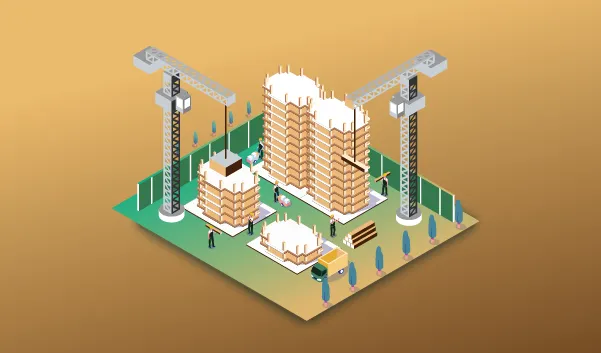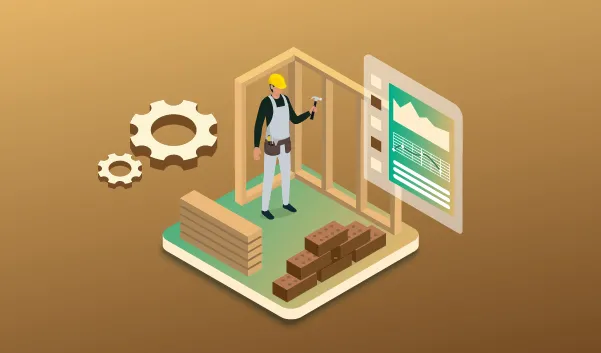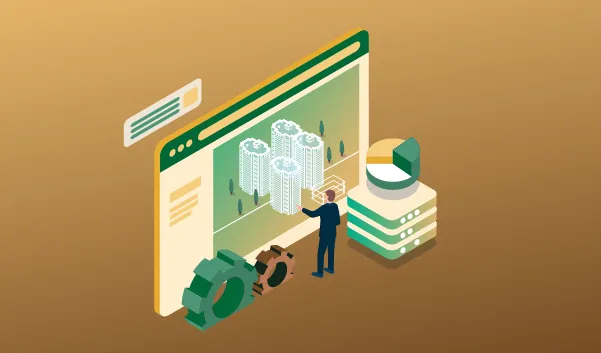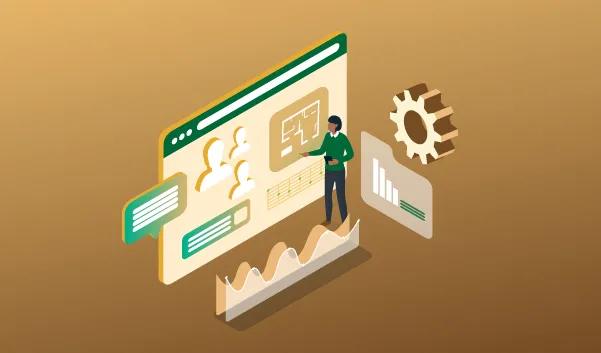Green Building Construction: Harnessing Digital Solutions for Decarbonization & Efficiency
To achieve greener buildings, companies need technology that can enable decarbonization efforts quickly and keep costs under control.
What is green building concept in construction?
Green building involves eco-conscious practices in every aspect, from site selection to design, construction, operation, maintenance, renovation, and even deconstruction. It prioritizes sustainability, reducing carbon emissions and promoting human health while preserving the natural environment.
Pursuing a Greener Purpose
Cities create a huge carbon footprint. As urban populations grow, they will continue to produce vast amounts of emissions and waste. Cities are responsible for 70% of greenhouse gas emissions, whereas the construction industry accounts for 38% of global energy-related emissions.
As a major employer and a major contributor, the construction industry also holds the solution for sustainability.
Reset and Improve the Way You Build
What can construction stakeholders do to accelerate sustainability? Explore how virtual twin can streamline construction projects, optimize construction processes and reduce energy consumption.
The Green Lining in Grey Buildings
There is an increasing number of sustainable innovations already in place to make the construction industry greener, which includes:
Using sustainable materials
Authorities are imposing carbon taxes that force the industry to be more responsible for its materials usage, such as using more recycled materials, including reused steel, and environmentally friendly materials like wood or bamboo.
"Productizing" construction
The Virtual Twin technology enables construction stakeholders to handle integration-ready construction modules, which help efficient onsite installation and shorten time delivery with fewer on-site workers.
Collaborating for energy efficiency
By leveraging modular assemblies, the number of actors responsible for the facade system can be reduced, while eliminating the risks of thermal bridges.
While efforts are underway to decarbonize the construction industry, a successful implementation is challenging without digitalization.
A key digital enabler in the pursuit of sustainable progress is an integrated cloud environment. This is where Dassault Systèmes’ 3DEXPERIENCE® platform delivers value. It enables companies to share data safely and easily while reducing large-scale inefficiencies across the construction value chain, resulting in less waste, cost and carbon emissions.
Reinvent the Construction Industry With Productization
Discover how integration-ready construction modules transform the value chain by accelerating the design and delivery of unique, sustainable buildings.
Building Better on the Cloud
On the cloud-based 3DEXPERIENCE platform, companies can create a virtual twin of the built environment and use it to test the implementation of more sustainable materials and construction techniques. This enables companies to improve manufacturing and construction processes while incorporating better sustainability consideration throughout the entire project lifecycle.
For companies aiming to construct sustainable buildings, the 3DEXPERIENCE platform allows them to:
- Virtually select environment-friendly materials
- Optimize and standardize construction processes
- Digitally simulate, build and test buildings
- Ensure digital continuity
Virtually select environment-friendly materials
By virtually exploring and choosing low-carbon structural materials, companies can measure the impact on emissions even before the materials reach the construction site. Through virtual simulation, Bouygues Group aims to reduce its concrete-related carbon intensity by 40% and increase the use of sustainable wood by 30%.
Optimize and standardize construction processes
Companies gain complete in-house control over every aspect of their work, from design, manufacturing, transportation to the assembly of building components. Digital technology enables Bouygues Group to build factories that can manufacture 2,000 modular apartments per year that are quick, clean and easy to assemble at the worksite. Additionally, this low-carbon autonomous social housing decreases water consumption by 70% and household waste by 40%.
Digitally simulate, build and test buildings
Companies can rely on digital engineering solutions to reduce a building’s long-term environmental impact. Through digital measurement, benchmarking, knowledge sharing, and implementation of best practices, companies can mitigate carbon-intensive processes, speed up construction and keep costs low. CadMakers created 3D structural models and simulations to complete the Tallwood House project about 70% faster and at less cost while reducing 2,432 metric tons of CO2.
Ensure digital continuity
Teams traditionally isolated from the construction process can collaborate on all project parameters, leading to better planning and resource management and reduced errors and design time. Leko Labs uses the 3DEXPERIENCE platform to simulate all aspects of the workflow and share designs among all stakeholders to perfect and optimize every element of a project digitally before committing to physical resources.
There is now a powerful, collaborative and scalable way to build and monitor sustainably, brick by brick — with the 3DEXPERIENCE platform.
Explore our Solutions for Sustainable Architecture and Greener Building Construction
Learn more about how our industry solutions can help you accelerate sustainable architecture and construct greener buildings
FAQ About Green Building Initiative & Technology
It prioritizes eco-friendly construction, employing efficient materials and practices. It harnesses natural elements via bio-climatic design, minimizes energy consumption, and relies on renewable power sources. Additionally, it emphasizes waste and water management, ensuring comfortable and healthy indoor environments.
Green construction centers on five key facets:
- Energy efficiency
- Water conservation
- Indoor air quality enhancement
- Sustainable material use
- Thoughtful site planning
While often used interchangeably, "green building" and "green construction" have separate meanings. "Green building" encompasses eco-responsible practices across a structure's life cycle, from inception to demolition. In contrast, "green construction" focuses on environmentally responsible materials and processes.
Green building construction entails environmentally responsible and resource-efficient practices throughout a structure's life cycle. Examples:
- Incorporating recycled and renewable materials
- Installing energy-efficient lighting and appliances
- Utilizing water-saving fixtures
It emphasizes efficient land and resource usage:
- Utilizing recycled materials
- Embracing renewable energy sources
- Implementing sustainable building methods.
Green building prioritizes resource efficiency and lessens a building's environmental footprint. Benefits of green construction:
- Enhanced air quality
- Lower energy and water usage
- Enhanced occupant health and well-being
- Cost savings throughout a building's lifespan
Additionally, green building conserves resources, minimizes waste, and fosters healthier, more efficient living and working spaces.
Green architecture, or sustainable architecture, involves environmentally conscious building design and construction. It aims to mitigate buildings' adverse environmental effects by enhancing energy efficiency, adopting renewable energy sources, and employing eco-friendly materials. Green structures minimize their impact on human health and the natural environment by conserving energy, water, and resources.
The integration of smart building and green construction is on the rise, as they share the common goals of minimizing energy use and environmental impact. Smart building construction concentrates on enhancing design, construction, and operation efficiency.
In contrast, green building construction aims to lessen environmental impact by using sustainable materials, energy-efficient designs, and renewable energy sources. Combining these approaches allows for energy-efficient and eco-friendly buildings.
Here is an overview of the efforts and methods used to build green buildings:
- Site Selection: Choose locations that minimize environmental impact and improve accessibility.
- Design: Focus on energy efficiency, water conservation, and indoor environmental quality using sustainable and low-impact materials.
- Construction Practices: Minimize waste and use energy-efficient construction methods.
- Energy Systems: Incorporate renewable energy sources and high-efficiency systems.
- Water Management: Implement water-saving fixtures and stormwater management systems.
- Operations and Maintenance: Use sustainable practices for ongoing maintenance and operations.
- Certification: Aim for green building certifications and continuously monitor performance to meet sustainability goals.
The Environmental Protection Agency (EPA) plays a significant role in green building construction through various programs, guidelines, and resources aimed at promoting sustainability and reducing environmental impact. Here’s how the EPA is linked to green building construction:
- Standards and Guidelines: Provides Energy Star certification for energy-efficient buildings and tools for improving indoor air quality.
- Certification Programs: Collaborates with programs like LEED to promote green building practices.
- Research and Resources: Conducts research and offers resources on sustainable building practices.
- Funding and Incentives: Offers grants and incentives for environmentally-focused building projects.
- Education and Outreach: Provides training and workshops on green building and sustainability.
Related Content with Green Architecture
Decarbonizing Industry Operations
Through digital transformation, industries can rethink their operations, from product design to supply chains, and move toward more sustainable, resource-efficient processes.
Clean Energy Technologies: Powering Up Innovation
Learn how you can revolutionize low-carbon technologies with an innovative platform
Modular Building - Why Productization Is the Future
Productization shakes up the construction world and transform the value chain by accelerating the design, delivery, and assembly of unique and sustainable buildings.
Virtual Twin Experiences in Infrastructure & Cities
Discover our commitment for urban sustainability to achieve the United Nations' Sustainable Development Goals



